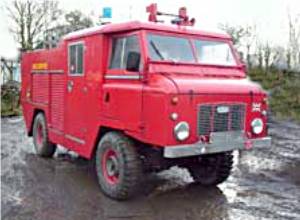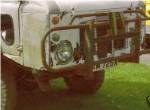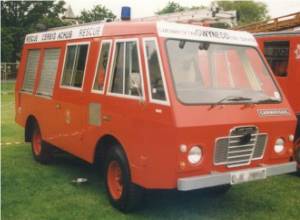Forward Control
Series IIa

Introduced in 1961, these vehicles were built on the Series IIa 109" chassis, and using the series IIa 2.25l 4-cylinder petrol or diesel engines.
The obvious differences in appearance to a regular Land Rover is that these vehicles have a boxy shape and large uniquely shaped diff cases,
the wheels are in each corner giving improved stability.
The driving position is above and in front of the engine, thus giving a much larger load area compared to other vehicles with the same wheelbase.
The tyres used are 9.00 x 16 on 6.5" wide rims with 11" drum brakes.
The first 151 vehicles produced used the same engine and running gear as a standard IIa; the steering boxes were then replaced with a lower-geared version.
These components were hidden under the truck bodywork and a new sub-frame is bolted to the front of the chassis creating a double-deck chassis.
This sub-frame of U-channel girders and uprights supports the tray and the cab.
Series IIa models can be distinguished from seriesIIb by their headlights, which are mounted centrally on a SeriesIIa, the indicator and park lights are positioned above and below respectively, also the rear mudguard was rounded.
Although this was the specification when models left the factory this is for guidance only, my research has shown that the front light configuration is not always standard.
The total production run is thought to have been 3193.
The vehicles that left the Solihull factory for commercial sale were either a dropside lorry or a flat-bed truck the latter had a load area big enough to carry an 80" Series I.
Specialist coachwork companies took delivery of a cab-chassis without the rear sub-frame or tray for conversions to be carried out.
The most common conversations are fire engines and ambulances.
The vehicle proved to be underpowered and top-heavy, the relatively narrow axles giving a 53.4" track made it an unstable vehicle.
Series IIb
 |
  |
Although very similar in appearance to a Series IIa FC they can be distinguished by the headlights mounted low down near the front bumper and the indicator and park lights above this, the rear mud guard was Squared off. As with the SeriesIIa this was the specification when models left the factory this is for guidance only, my research has shown that the front light configuration is not always standard.
The vehicle has strengthened differential and new ENV axles with heavier springs and an increased track to 57.5". An anti-roll bar was fitted to the front and the gearchange linkage was simplified.
Inside the vehicle a new instrument layout was introduced along with new handbrake and gear levers. An interlinked screen wiper arrangement was also introduced.
The increase track helped with the stability issue but it was still underpowered. The total production run is thought to have been around 2305.
101 1-tonne
Land Rover developed a shorter wheel based vehicle the 101" 1-tonne
Series III
 Series III FC variations were produced without official Rover recognition using Series III 109" vehicles as donors, examples of these vehicles are Fire Tenders of Ambulances.
Carmichaels produced Series III FC Fire tenders as pictured here.
I think these had a very space age look to them for the period and would have made fantastic ice-cream vans.
Series III FC variations were produced without official Rover recognition using Series III 109" vehicles as donors, examples of these vehicles are Fire Tenders of Ambulances.
Carmichaels produced Series III FC Fire tenders as pictured here.
I think these had a very space age look to them for the period and would have made fantastic ice-cream vans.
F.I. Bates of Evesham converted around 52 vehicles into FC Fire Engines mostly for the Northern Ireland Fire Brigade.
FC82
Launched in 1982, developed by SMC Engineering these vehicles were built on a 139" wheelbase using a 4x4 and a 6x6 configuration. Back to back seats were fitted facing front and rear, designed to carry a full platoon. The rear body was fitted with dropsides, a drop tail and a canvas roof. The 6X6 had the fuel tank fitted above the rear axles and below the body; the 4X4 used a standard Landrover fuel tank.
88" FC
Land Rover also built a prototype 88" Forward Control vehicle, pitching was a major problem and the project dropped. Specialist coachbuilder Alfred Miles also built 88" vehicles, two of these became prototype Dennis fire engine conversions.
Llama
 Land Rover development a spin off from the 101 1-tonne, this was the Llama, 8 Prototype vehicles built in 1986 on 101" 1-tonne chassis, using the V8 engine.
This vehicle resembled a Leyland 45 truck but had off road capabilities inherent in all Landrovers.
It was developed to meet MOD requirements for an off road transport vehicle although it met these requirements Land Rover did not get the order.
Land Rover development a spin off from the 101 1-tonne, this was the Llama, 8 Prototype vehicles built in 1986 on 101" 1-tonne chassis, using the V8 engine.
This vehicle resembled a Leyland 45 truck but had off road capabilities inherent in all Landrovers.
It was developed to meet MOD requirements for an off road transport vehicle although it met these requirements Land Rover did not get the order.
Defender
I recently witnessed some FC vehicles in the secure compound of BAE Systems (formally Vickers Armstrong) the Challenger II tank producers, these appeared to be Land Rover conversions.
They were parked next to Defender armoured Landrovers painted in UN livery which reinforced my thought that the FC vehicles were Land Rover based.
Such vehicles do not appear to be listed as been produced by the company.
Unfortunately I could not get close enough to the security fence to take any pictures, I did email customer services but got no reply obviously PR is of no interest to BAE.